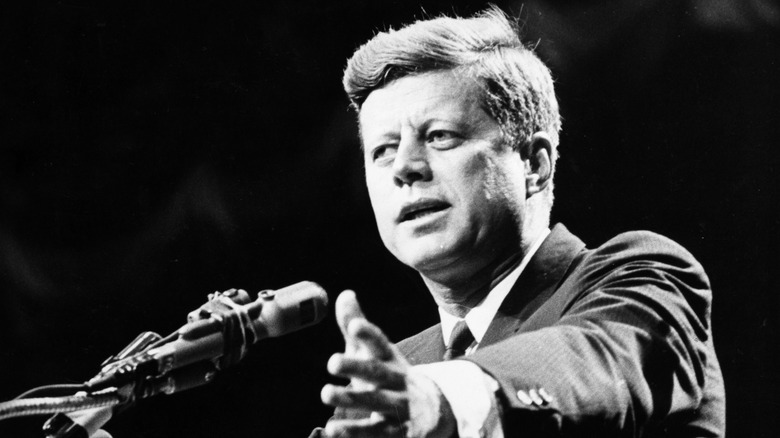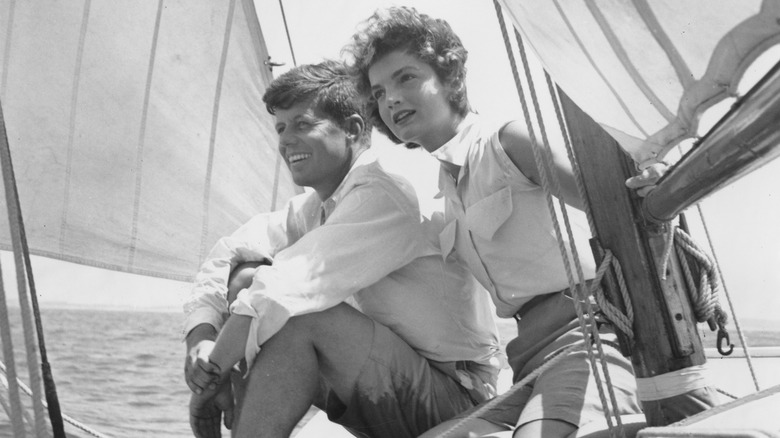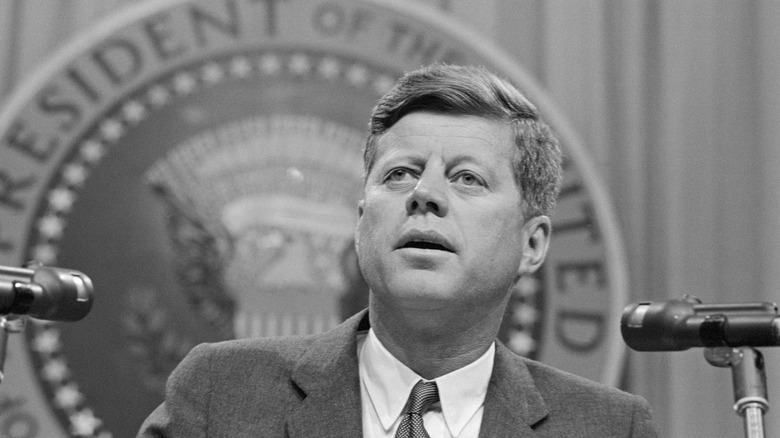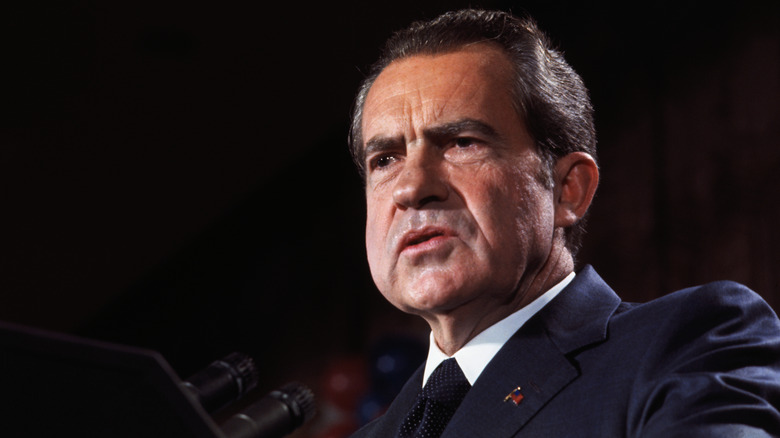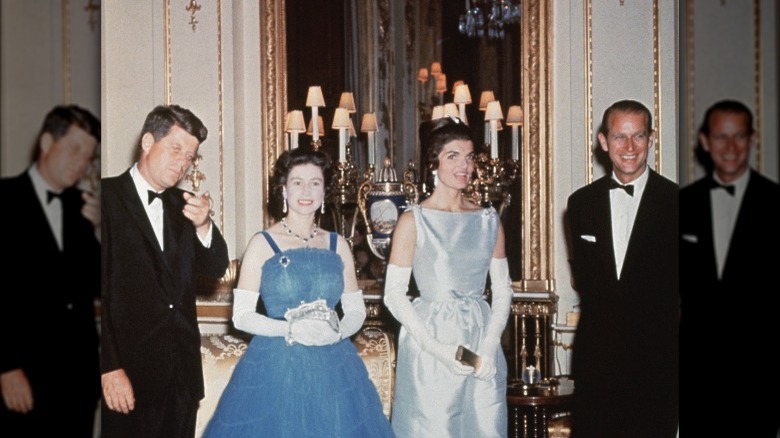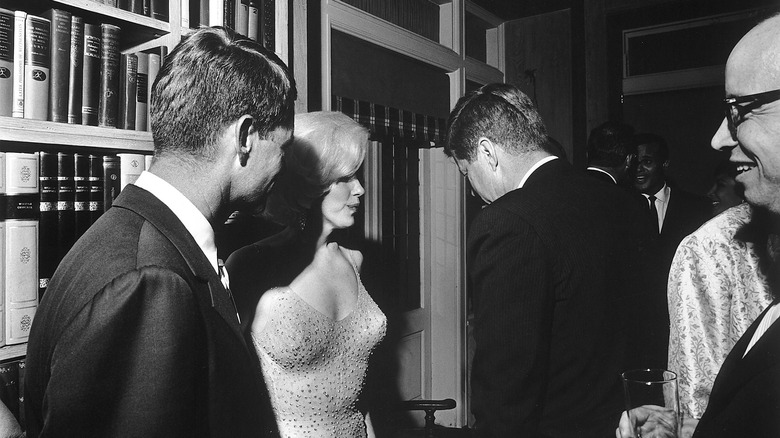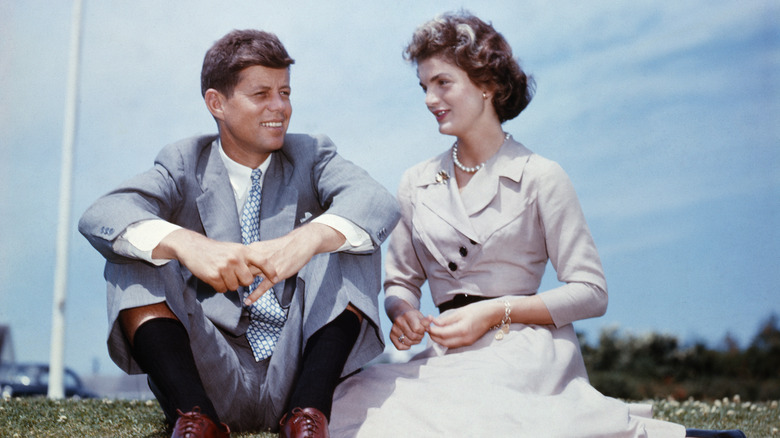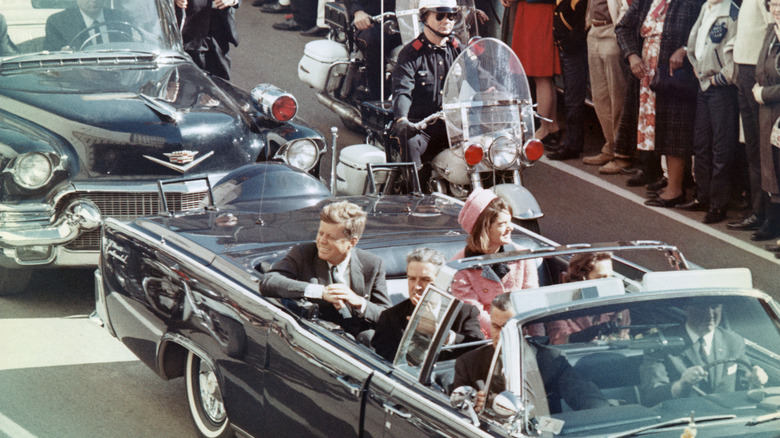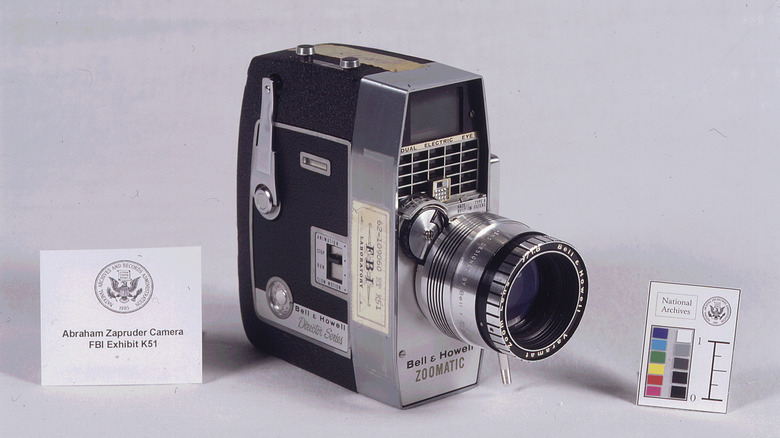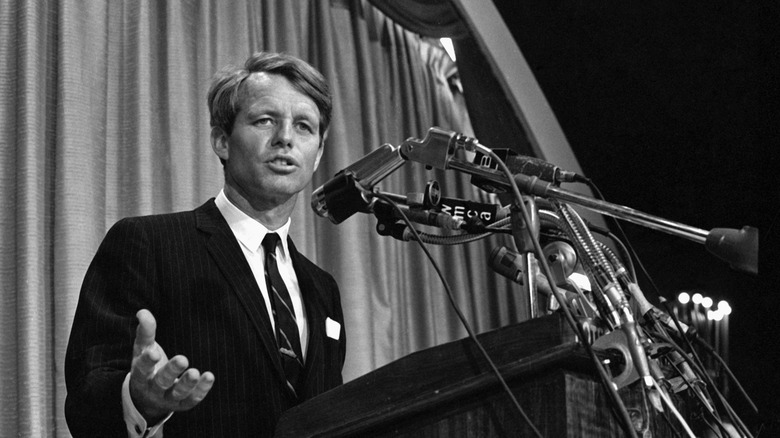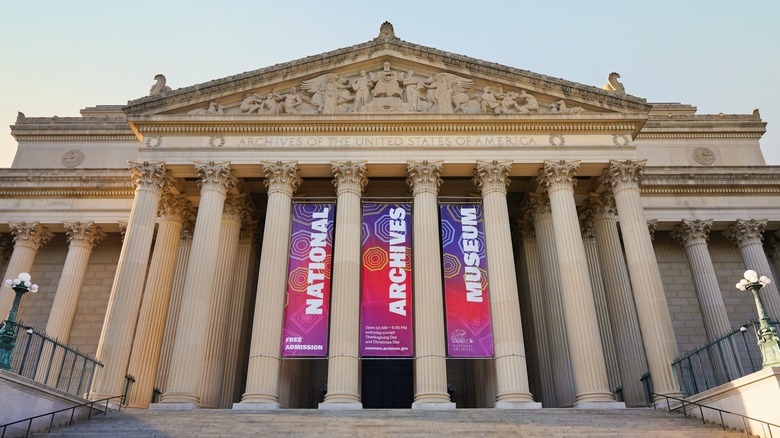Things We Learned About JFK After He Died
For a country that doesn't technically have any sort of old-school nobility or royalty, the Kennedy family might be the closest thing that the United States has. They're something close to a longstanding political dynasty in its own right — which is pretty unique in American history — and that's made it a regular source of mystique for the public at large. That's been pretty true for a long time, even if you were to ignore one of the most infamous events to strike at the Kennedy family: the assassination of John F. Kennedy, of course.
Conspiracies and questions have been thrown around on that front for literal decades, and no shortage of people have tried to spend that time trying to unravel the mysteries of JFK's death. All with varying levels of success. That said, Kennedy assassination conspiracy theories are full topics in and of themselves, and it might be worth noting that for all the questions that continue to linger, there are actually some tidbits of information that have been revealed in the past six decades. Naturally, some of it ties back into JFK's assassination on November 22, 1963, but there are some other details that have even managed to paint the former president in a slightly different light. Here are some of the things the public learned about JFK after he died.
JFK's youthful, healthy image was just a facade
At the age of 43, John F. Kennedy was the youngest person ever to be elected to the presidency, and during his time in office, a not inconsiderate amount of his public image was meant to reflect that youthfulness, energy, and vigor. Ultimately, his short-lived presidency was rather successful in projecting that idea, and it's still remembered in that light to this day. In reality, though, JFK wasn't actually the strapping young pinnacle of health that his administration liked to tout.
Actually, the opposite was true. After the assassination, the Kennedy family reportedly implored the pathologists performing JFK's autopsy not to look at his abdominal cavity. They did, anyway, and they finally, officially opened up on their findings in the early 1990s: The president's adrenal glands (responsible for producing certain hormones) were functionally gone, a kind of condition that would typically be life-threatening. And he'd been managing his chronic health conditions with regular treatments, often consisting of corticosteroid injections — a way for him to get the hormones that he was missing.
When exactly he started taking those injections is still something of a mystery; around his 1947 diagnosis has been put forward by biographers of JFK, though some speculate that it was actually some time earlier than that. Medical professionals have further explained that such long-term usage of steroids probably caused some of Kennedy's other chronic health issues, like osteoporosis, fractured vertebrae, arthritis, and lifelong back pain.
JFK lied to secure his candidacy
It might be understandable to discover that JFK had health issues, and that the exact extent of them were being somewhat obscured from public view. But it's another to have apparent evidence that the Kennedy family pretty much lied to the press.
In private, JFK was dealing with Addison's Disease, and it's a very serious (albeit treatable) condition that affects the adrenal glands. And interviewers at the time were somewhat wise to the fact that something was wrong, forcing both Kennedy and his brother, Robert F. Kennedy, to speak on the topic. RFK only mentioned a mild deficiency in the past, saying, "[He] does not now nor has he ever had an ailment described classically as Addison's disease" (via The New York Times). JFK put out a similar statement, explaining, "No one who has the real Addison's disease should run for the presidency, but I do not have it" (via PBS). And the devil really was in the details: The original reports of Addison's Disease from 1855 all noted that it appeared after a bout of tuberculosis; JFK had been diagnosed with it despite having never contracted tuberculosis. That was enough for the Kennedy family to claim that JFK hadn't truly been diagnosed with the real Addison's Disease, as it hadn't stemmed from the same source.
Deceitful in a lot of ways, and it was probably used to great effect. Historians have genuinely speculated that JFK may have never won the presidency had the American public known that he was chronically ill.
Nixon wasn't the only one to employ secret tapes
Let's fast forward about a decade, to the presidency of Richard Nixon. If there's one thing associated with Nixon, it's probably the secrets of the Watergate Scandal, and one of the centerpieces of that whole ordeal was the existence of a secret recording system, installed in the White House and capturing audio of all of Nixon's conversations.
But as it turned out, the revelation that Nixon had installed an extensive recording system also proved that he wasn't the only president to do so. Far from it: Every president from Franklin D. Roosevelt to Nixon installed their own version of a recording system, John F. Kennedy included. As it was eventually revealed, that system was installed over the course of 1962, though Kennedy's exact reasons for doing so have always been an unanswered question.
Members of his administration have recalled that this request came after the Bay of Pigs invasion in 1961, suspecting that it was prompted by his advisors lying about their level of support for that operation. As best anyone could tell, the tapes would serve as a permanent record, whether to keep people honest, or for him to have accurate information for later personal use. There were well over 200 hours of audio captured on those tapes — notably a ton of discussion on the Cuban Missile Crisis — though they wouldn't be fully declassified until about two decades after Kennedy's death.
Coining the name 'Camelot'
There's a fairly whimsical term associated with the Kennedy family: Camelot. It was coined as a reference to John F. Kennedy's administration, and the name evokes the sense of fantasy and idealism that's now become intertwined with the time period. Kennedy himself has almost gained the legacy of a great hero, by merit of his presidency being forever compared to King Arthur's kingdom of lore.
For all that the association has cemented itself in the minds of modern Americans, it wasn't always attached to the Kennedy family; JFK himself never actually lived to see that moniker. The first time Camelot was referenced with the Kennedys was in the weeks following JFK's assassination, during an interview Jacqueline Kennedy Onassis gave with LIFE Magazine. In it, she explained that her husband would often play a record before bed, and that the last song had a line she couldn't get out of her head: "Don't let it be forgot, that once there was a spot, for one brief shining moment that was known as Camelot." The line comes from the 1960 musical "Camelot," and she went on to draw more direct connections, speaking of heroism and idealism within the Kennedy administration, then comparing it to all those that would follow: "There'll be great Presidents again ... but there'll never be another Camelot again."
While there are arguments to be had about whether the term is apt, there's no denying that it has endured the test of time.
Photos of JFK and Marilyn Monroe were almost nonexistent
There's quite a bit of mystery and conspiracy associated with reports that Marilyn Monroe had affairs with both John F. Kennedy and Robert F. Kennedy. The exact accuracy of those stories is a matter of debate in and of itself, with some pointing to various times when the two were thought to be together, or Monroe's apparently sultry performance of "Happy Birthday" for JFK in May 1962. (Aside from the conspiracies connecting the Kennedys to the truth of Marilyn Monroe's death.)
That said, despite the plentiful photos of both Kennedy brothers and Monroe — and all the rumors that she was romantically involved with both of them — there was no photographic evidence to prove that they'd ever even been in the same room. At least, not until decades later.
As it turns out, there's a single known photo to exist that depicts Monroe with not just one of the Kennedy brothers, but both of them. It was taken at the event in which she famously sang "Happy Birthday," and features Monroe in a stunning dress, standing right between the Kennedys and accompanied by members of their staff. The photo (shown above) was taken by Cecil Stoughton, who proceeded to keep its existence a complete secret and reportedly only printed a couple of copies from his original negative. Those prints wouldn't be discovered until after his death in 2008, and they weren't released to the public for a couple more years after that, nearly 50 years after JFK's death.
JFK was really concerned about his self-image
Body image is a pretty big topic in the modern day and age, but that doesn't mean those same issues were non-existent in decades past. Even the famous Kennedys dealt with some very familiar insecurities.
According to Thurston Clarke's "JFK's Last Hundred Days," both John F. Kennedy and Jacqueline Kennedy Onassis were very concerned with their respective public images. Jacqueline wore gloves to hide her hands and nails, and JFK avoided swimming out of concern for the way his body looked in the water. He was evidently so concerned about his body weight that he would even travel with a bathroom scale in his luggage, just to keep a vigilant eye on that number.
In a lot of ways, it wasn't all that far off from how JFK was raised. Kate Clifford Lawson's "Rosemary" details the ways in which the Kennedy family's matriarch, Rose Kennedy, ran the household. She famously kept note cards with each of her childrens' medical history and even instituted a "Saturday-morning weigh-in," which she used to keep meticulous track of their weights. If ever that number varied just a little too much, she would make changes to their diets or exercise, adamant that none of them would ever become "emaciated ... fat ... [or] shapeless." A set of concerns that would become something of a legacy left behind to her kids and grandkids.
The Warren Commission's conclusions might be flawed
The questions and conspiracies surrounding the assassination of John F. Kennedy are many and varied, whether they be the mystery of the Umbrella Man or the story of Abraham Zapruder capturing the assassination on film. That said, there are some interesting recent developments to the story that do call previous conclusions into question.
For one, the Warren Commission has long insisted that Lee Harvey Oswald was able to fire a single bullet that passed through both Kennedy and Governor John Connally. That a conclusion was partially drawn after a bullet was found on Connally's stretcher, presumably after it had slipped out of his wounds. Critics have thought that was all too much for one bullet to do, though, taking to calling it the "magic bullet" theory. Debate has gone back and forth over that, but in late 2023, Secret Service agent Paul Landis came forward, explaining that he was the one who placed the bullet there. In fact, he'd been just inches from Kennedy when the attack happened, and in the ensuing chaos, he found the bullet lodged in the seat, just behind where Kennedy had been. He picked it up, only thinking about keeping evidence safe, then placed it on the president's (not Connally's) stretcher, hoping it would solve the mystery.
But it's only made the mystery even more confusing. If that bullet was never inside of Connally, then where did it come from?
Frame 313 of the Zapruder Film
One of the most famous pieces of evidence from the JFK assassination is known as the Zapruder Film — a 26-second film captured by dressmaker Abraham Zapruder, and the only known recording of the entire assassination. And while common sense would dictate that a video should clear up all questions, it turns out the opposite is true.
The Warren Commission was given this film to recreate the timeline of JFK's assassination, and they used it to justify their argument that Lee Harvey Oswald had acted as a lone gunman, killing Kennedy with a shot from behind. But word eventually got out that Zapruder had also made a separate request: That frame 313 (the moment when Kennedy was lethally shot) be hidden from the public. That image alone had given him nightmares, and he didn't want the rest of the public to live with that horror. But his wishes didn't last, and in 1975, the full version of the film — frame 313 included — was played to a national audience.
Suddenly, the whole nation had seen the moment of Kennedy's death, but keen-eyed critics spotted something strange. The Warren Commission had said that Kennedy was hit from behind, but frame 313 seemed to depict his head being blown backward, as if he was hit from the front. Whether that's an indication of a second shooter, an optical illusion, or any number of other things is a matter of debate, but its reveal spawned a whole new wave of conspiracy theories, as well as a widespread distrust of the CIA.
JFK's brain disappeared
There is one particularly macabre detail from the events after JFK's assassination: JFK's brain mysteriously disappeared. (Fair warning, this does get a little bit gross.)
In the immediate aftermath of the assassination, Kennedy's body was taken for an autopsy, during which time the pathologists had to remove his brain. They placed it inside a stainless steel container, screwed on the lid, and proceeded to forget to return it to Kennedy's body for his funeral. Instead, that jar was shuttled around with other pieces of medical evidence, sitting inside of a cabinet with the Secret Service, then left inside of a locker that was sent to the National Archives. And at that point, the story gets a little bit fuzzier. All anyone knows for sure is that by 1966 — three years later — that entire locker had suddenly vanished, taking Kennedy's brain with it, never to be seen again.
As for the possible suspects, one theory posits that Robert F. Kennedy (pictured above) actually pulled off the theft himself, potentially in order to hide the poor state of his brother's health. Alternatively, conspiracy lovers have insisted that the heist was done to hide possible evidence that JFK had actually been shot from the front. Of course, no one is certain of any motives, nor can anyone say what even happened to Kennedy's brain in the end.
There's still plenty that the public doesn't know
John F. Kennedy was not only a president at the center of a conspiracy-laden assassination, but also a member of a prominent political family with a history of hiding information. So it might not surprise anyone that, at least when it comes to the assassination, there's seemingly solid evidence that the American public doesn't have access to all of the, well, solid evidence.
In response to the rising cries of conspiracy and deception regarding the assassination, in 1992, Congress passed the John F. Kennedy Assassination Records Collection Act, essentially mandating that all agencies declassify all related records and submit them to the National Archives, where they could be accessed by the public, within 25 years. And if you do the math, that deadline rolled around in 2017. At which point, President Donald Trump agreed to extend that deadline. Come 2023, and President Joe Biden actually announced that agencies like the CIA and FBI could release those documents whenever they saw fit, rather than adhering to a deadline at all. Despite thousands of documents still being at least partially classified.
Responses have been unsurprisingly mixed. Government agencies have explained that declassifying documents could compromise living assets or locations actively in use since the 1960s. Cynical members of the public take it all as a sign that the government still has something worth hiding. Whether that frustration turns into anything is something only more time can tell.
